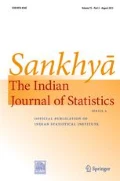Abstract
We study independent random variables (Zi)i∈I aggregated by integrating with respect to a nonatomic and finitely additive probability ν over the index set I. We analyze the behavior of the resulting random average \({\int }_I Z_i d\nu (i)\). We establish that any ν that guarantees the measurability of \({\int }_I Z_i d\nu (i)\) satisfies the following law of large numbers: for any collection (Zi)i∈I of uniformly bounded and independent random variables, almost surely the realized average \({\int }_I Z_i d\nu (i)\) equals the average expectation \({\int }_I E[Z_i]d\nu (i)\).
Similar content being viewed by others
References
Al-Najjar, N.I. (2008). Large games and the law of large numbers. Games Econom. Behav.64, 1, 1–34.
Berti, P. and Rigo, P. (2006). Finitely additive uniform limit theorems. Sankhyā: The Indian Journal of Statistics (2003–2007)68, 1, 24–44.
Christensen, J.P.R. (1971). Borel structures and a topological zero-one law. Math. Scand.29, 2, 245–255.
Christensen, J.P.R. (1974). Topology and Borel structure. North Holland, Amsterdam.
Dalal, S. (1978). A note on the adequacy of mixtures of Dirichlet processes. Sankhyā: The Indian Journal of Statistics, Series A (1961–2002)40, 2, 185–191.
Feldman, M. and Gilles, C. (1985). An expository note on individual risk without aggregate uncertainty. J. Econ. Theory35, 1, 26–32.
Fisher, A. (1987). Convex-invariant means and a pathwise central limit theorem. Adv. Math.63, 3, 213–246.
Fremlin, D.H. and Talagrand, M. (1979). A decomposition theorem for additive set-functions, with applications to Pettis integrals and ergodic means. Mathematische Zeitschrift168, 2, 117–142.
Gangopadhyay, S. and Rao, B.V. (1999). On the hewitt-savage zero one law in the strategic setup. Sankhyā: The Indian Journal of Statistics, Series A, 153–165.
Gilboa, I. and Matsui, A. (1992). A model of random matching. J. Math. Econ.21, 2, 185–197.
Judd, K.L. (1985). The law of large numbers with a continuum of iid random variables. J. Econ. Theory35, 1, 19–25.
Kadane, J.B. and O’Hagan, A. (1995). Using finitely additive probability: uniform distributions on the natural numbers. J. Am. Stat. Assoc.90, 430, 626–631.
Kallianpur, G. and Karandikar, R.L. (1988). White Noise Theory of Prediction, Filtering and Smoothing, 3. CRC Press, Boca Raton.
Kamae, T., Krengel, U. and O’Brien, G.L. (1977). Stochastic inequalities on partially ordered spaces. The Annals of Probability5, 6, 899–912.
Karandikar, R.L. (1982). A general principle for limit theorems in finitely additive probability. Trans. Am. Math. Soc.273, 2, 541–550.
Larson, P.B. (2009). The filter dichotomy and medial limits. J. Math. Log.9, 02, 159–165.
Maharam, D. (1976). Finitely additive measures on the integers. Sankhyā: The Indian Journal of Statistics, Series A (1961–2002)38, 1, 44–59.
Meyer, P.-A. (1973). Limites médiales, d’après Mokobodzki, Séminaire de probabilités VII. Springer, Berlin, p. 198–204.
Nutz, M. et al. (2012). Pathwise construction of stochastic integrals. Electron. Commun. Probab., 17.
Paul, E. (1962). Density in the light of probability theory. Sankhyā: The Indian Journal of Statistics, Series A (1961–2002)24, 2, 103–114.
Purves, R. and Sudderth, W. (1983). Finitely additive zero-one laws. Sankhyā: The Indian Journal of Statistics, Series A (1961–2002)45, 1, 32–37.
Uhlig, H. (1996). A law of large numbers for large economies. Econ. Theory8, 1, 41–50.
Author information
Authors and Affiliations
Corresponding author
Additional information
Publisher’s Note
Springer Nature remains neutral with regard to jurisdictional claims in published maps and institutional affiliations.
Rights and permissions
About this article
Cite this article
Al-Najjar, N.I., Pomatto, L. An Abstract Law of Large Numbers. Sankhya A 82, 1–12 (2020). https://doi.org/10.1007/s13171-018-00162-z
Received:
Published:
Issue Date:
DOI: https://doi.org/10.1007/s13171-018-00162-z


